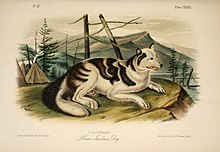
The coyote, also known as the American jackal, prairie wolf, or brush wolf, is a species of canine native to North America. It is smaller than its close relative, the gray wolf, and slightly smaller than the closely related eastern wolf and red wolf. It fills much of the same ecological niche as the golden jackal does in Eurasia; however, the coyote is generally larger.

The wolf, also known as the gray wolf or grey wolf, is a large canine native to Eurasia and North America. More than thirty subspecies of Canis lupus have been recognized, including the dog and dingo, though gray wolves, as popularly understood, only comprise naturally-occurring wild subspecies. The wolf is the largest extant member of the family Canidae, and is further distinguished from other Canis species by its less pointed ears and muzzle, as well as a shorter torso and a longer tail. The wolf is nonetheless related closely enough to smaller Canis species, such as the coyote and the golden jackal, to produce fertile hybrids with them. The wolf's fur is usually mottled white, brown, gray, and black, although subspecies in the arctic region may be nearly all white.

A dog breed is a particular type of dog that was purposefully bred by humans to perform specific tasks, such as herding, hunting, and guarding. Dogs are the most variable mammal on Earth, with artificial selection producing upward of 360 globally recognized breeds. These breeds possess distinct traits related to morphology, which include body size and shape, tail phenotype, fur type, etc, but are only one species of dog. Their behavioral traits include guarding, herding, and hunting, and personality traits such as hyper-social behavior, boldness, and aggression. Most breeds were derived from small numbers of founders within the last 200 years. As a result of their adaptability to many environments and breedability for human needs, today dogs are the most abundant carnivore species and are dispersed around the world.

The American Eskimo Dog is a breed of companion dog, originating in Germany. The American Eskimo Dog is a member of the Spitz family. The breed's progenitors were German Spitz, but due to anti-German sentiment during the First World War, it was renamed "American Eskimo Dog." Although modern American Eskimo Dogs have been exported as German Spitz Gross, the breeds have diverged and the standards are significantly different. In addition to serving as a watchdog and companion, the American Eskimo Dog also achieved a high degree of popularity in the United States in the 1930s and 1940s as a circus performer.

A wolfdog is a canine produced by the mating of a domestic dog with a gray wolf, eastern wolf, red wolf, or Ethiopian wolf to produce a hybrid.

Husky is a general term for a dog used in the polar regions, primarily and specifically for work as sled dogs. It refers to a traditional northern type, notable for its cold-weather tolerance and overall hardiness. Modern racing huskies that maintain arctic breed traits represent an ever-changing crossbreed of the fastest dogs.

A spitz is a type of domestic dog consisting of between 50 and 70 breeds depending on classification. There is no precise definition of 'spitz' but typically most spitz breeds have pricked ears, almond shaped eyes, a pointed muzzle, a double coat, and a tail that curves over the back.

Dog communication is the transfer of information between dogs, as well as between dogs and humans. Behaviors associated with dog communication are categorized into visual and vocal. Visual communication includes mouth shape and head position, licking and sniffing, ear and tail positioning, eye gaze, facial expression, and body posture. Dog vocalizations, or auditory communication, can include barks, growls, howls, whines and whimpers, screams, pants and sighs. Dogs also communicate via gustatory communication, utilizing scent and pheromones.

The Karelian Bear Dog is a Finnish breed of dog. In its home country, it is seen by many as a national treasure. Karelian Bear Dogs will hunt a variety of animals. Its quick reflexes and fearless nature have made it very popular for hunting large game including brown bears, moose, and wild boar. It was the breed's ability to hunt bears that earned the breed its name. The Karelian Bear Dog is among the top 10 most common dog breeds in Finland.
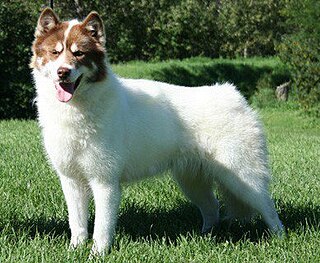
The Canadian Eskimo Dog or Canadian Inuit Dog is a breed of working dog from the Arctic. Other names include qimmiq or qimmit. The Greenland Dog is considered the same breed as the Canadian Eskimo Dog since they have not yet diverged enough genetically to be considered separate breeds, despite their geographic isolation.

A bark is a sound most often produced by dogs. Other animals that make this noise include, but are not limited to, wolves, coyotes, foxes, seals, frogs, and barking owls. "Bark" is also a verb that describes the sound of many canids.

The New Guinea singing dog or New Guinea Highland dog is an ancient (basal) lineage of dog found in the New Guinea Highlands, on the island of New Guinea. Once considered to be a separate species in its own right, under the name Canis hallstromi, it is closely related to the Australian dingo. The dog is relatively unusual among canines; it is one of the few to be considered "barkless", and is known for the unusual "yodel"-like style of vocalizing that gives it its name.

The West Siberian Laika or WSL, is a breed of spitz–type hunting dog. Russian publications indicate that the term West Siberian Laika loosely applied to hunting dogs originating with the Mansi and Khanty people in Ural and West Siberia, but there were no standards or registrations of WSL as such until 1930. Then WWII disrupted it for a while, but systematic breeding with registrations resumed after the war ended, in 1946. This was the time the breed began taking modern shape. Before that hunters only knew of Mansi Laika and Khanty Laika. In early 1960 many hunters in Ural still preferred the term Mansi Laika, when speaking of West Siberian Laika. In Russian language, the term Laika originated from the word layat that means to bark. The word Laika simply means barker. Any hunting Laika is a bark pointer. It is a versatile dog depending on use and environment, but in certain parts of the country they have become more specialized.
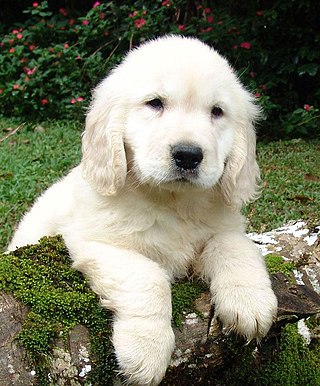
A puppy is a juvenile dog. Some puppies can weigh 1–1.5 kg (2.2–3.3 lb), while larger ones can weigh over 7 kg (15 lb). All puppies display primary altriciality and healthy puppies grow quickly after birth. A puppy's coat color may change as the puppy grows older, as is commonly seen in breeds such as the Yorkshire Terrier. Puppy refers specifically to young dogs, while pup may be used for other animals such as wolves, seals, giraffes, guinea pigs, rats or sharks.

A black wolf is a melanistic colour variant of the gray wolf. Black specimens were recorded among red wolves, though the colour phase in this species is not extinct yet. Genetic research from the Stanford University School of Medicine and the University of California, Los Angeles revealed that wolves with black pelts owe their distinctive coloration to a mutation which occurred in domestic dogs, and was carried to wolves through wolf-dog hybridization. Besides coat and knee colour, they are normal grey wolves.

The Sabueso Español or Spanish Hound is a scenthound breed with its origin in the far north of Iberian Peninsula. This breed has been used in this mountainous region since hundreds of years ago for all kind of game: wild boar, hare, brown bear, wolf, red deer, fox, roe deer and chamois. It is an exclusive working breed, employed in hunting with firearms.

Pound Puppies is an animated children's television series developed by Wendy Klein Moss, Nancy Steingard, Paul Germain and Joe Ansolabehere for the Hub Network. It premiered on October 10, 2010 in the United States as the first Hub "original series". It also aired on YTV in Canada and on Boomerang in the United Kingdom, Ireland and Australia. Produced by Hasbro Studios, it was the second series to adapt Pound Puppies into a cartoon format. Originally a property by Tonka, Hasbro acquired Tonka itself and currently manages Pound Puppies. The plot style and music were similar to the 1960s TV series Hogan's Heroes and to films like Stalag 17 and The Great Escape. The first seven episodes of the series were animated by 9 Story Entertainment, but DHX Media/Vancouver took over to animate the series from episode 8 onwards.

The Indian pariah dog, also known as the Indian native dog, INDog, Nadan,South Asian pye dog, Desi Kutta, and Neri Kutta, is a landrace of dog native to the Indian subcontinent. They have erect ears, a wedge-shaped head, and a curved tail. It is easily trainable and often used as a guard dog and police dog. This dog is an example of an ancient group of dog known as pye-dogs. There is archaeological evidence that the dog was present in Indian villages as early as 4,500 years ago.
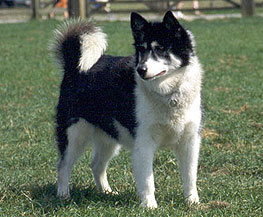
Native American dogs, or Pre-Columbian dogs, were dogs living with people indigenous to the Americas. Arriving about 10,000 years ago alongside Paleo-Indians, today they make up a fraction of dog breeds that range from the Alaskan Malamute to the Peruvian Hairless Dog.
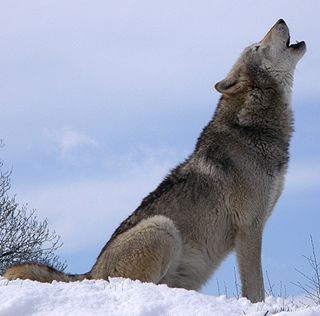
Howling is a vocal form of animal communication seen in most canines, particularly wolves, coyotes, foxes, and dogs, as well as cats and some species of monkeys. Howls are lengthy sustained sounds, loud and audible over long distances, often with some variation in pitch over the length of the sound. Howling is generally used by animals that engage in this behavior to signal their positions to one another, to call the pack to assemble, or to note their territory. The behavior is occasionally copied by humans, and has been noted to have varying degrees of significance in human culture.
